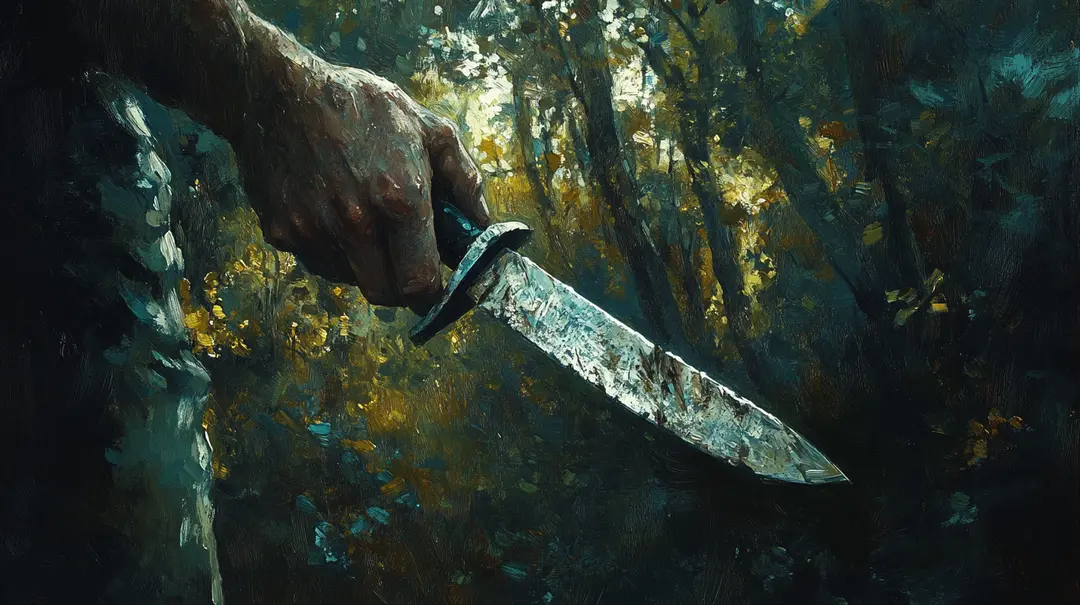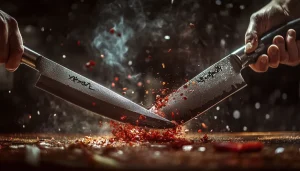When the rifle stays at home, the knife takes center stage. Hunting with a knife is not just about the pursuit of prey—it’s a raw, primal experience that tests your skill, patience, and courage. For those seeking the ultimate challenge, knife hunting offers a connection to nature and tradition like no other.
The Appeal of Knife Hunting
The Adrenaline Rush

There’s nothing quite like the thrill of hunting at close quarters. The adrenaline rush kicks in as soon as the hunt begins—your heart races, your senses sharpen, and every sound and movement in the environment becomes amplified. This intense physiological response is fueled by a surge of adrenaline, preparing your body for action by increasing your focus, strength, and speed. Hunters are drawn to this heightened state because it creates an unparalleled sense of being alive and deeply connected to the moment. The rush often peaks during the final stages of the stalk, when the prey is within range and the success of the hunt hinges on every calculated move. This combination of anticipation and action is what makes knife hunting an exhilarating and unforgettable experience.
A Test of Skill
Knife hunting is not for the faint of heart. It requires mastery of tracking, stalking, and understanding your prey. Each hunt becomes a testament to your abilities as a hunter, sharpening multiple skillsets along the way. Hunters often discover and refine their ability to move silently and efficiently through dense terrain, enhancing stealth and patience. They develop keen observational skills, learning to interpret animal tracks, sounds, and subtle changes in the environment. Knife hunting also demands mental resilience, pushing hunters to stay focused under pressure and adapt quickly to unexpected situations. These skillsets not only define success in the field but also build a deeper connection with the natural world.
Connection to Tradition
Knife hunting harkens back to the roots of human survival. Long before firearms, our ancestors relied on blades for hunting. Embracing this method is a way to honor those traditions and experience the wilderness in its purest form.
Choosing the Right Knife for Hunting
Essential Features in a Hunting Knife
- Blade Type: Fixed blades are sturdy and reliable, while folding knives are more compact. A drop-point blade is ideal for hunting due to its strength and versatility.
- Blade Material: High-carbon steel offers durability and sharpness retention, while stainless steel provides resistance to corrosion.
- Handle Grip: A comfortable, non-slip grippy handle is crucial for safety and control, especially in wet conditions.
Top Knife Recommendations
- Ka-Bar Becker BK2: Known for its durability and versatility, this knife features a 5.25-inch fixed blade made of 1095 Cro-Van steel, designed to handle heavy-duty tasks like chopping and batoning. Its primary purpose is as a survival tool, making it ideal for hunters who need a reliable, multipurpose blade in the wilderness.
- Buck Knives 119 Special: A classic hunting knife with excellent balance, the 6-inch clip-point blade excels at precise cuts and skinning. Crafted from 420HC steel, its unique feature is its mirror-polished finish, offering both corrosion resistance and a traditional aesthetic. Originally designed for hunters, it’s perfect for field dressing and smaller game tasks.
- ESEE-6: Praised for its sharp edge and rugged build, this knife boasts a 6.5-inch full tang blade made of 1095 carbon steel. Designed primarily for survival and tactical use, its durability and ergonomic Micarta handle make it an excellent choice for processing larger game like wild boar. The knife’s reliability in extreme conditions makes it a favorite among outdoor enthusiasts.
Techniques for Hunting with a Knife
Preparation
Knife hunting demands both physical and mental preparation. Start by researching the local terrain and understanding the typical behavior and patterns of your prey. Familiarize yourself with the landscape, noting potential hiding spots, water sources, and trails. Conditioning your body is equally important; focus on building strength, agility, and endurance through exercises like hiking and core training. Mental preparation includes practicing patience, learning to stay calm under pressure, and visualizing different hunting scenarios to sharpen your instincts. Proper preparation ensures you’re ready to face the challenges of knife hunting with confidence.
Tracking and Stalking
- Tracking: Learn to identify tracks, scat, and other signs of animal presence. For example, wild boar tracks are often large and cloven, with distinct dew claw marks, while hog scat tends to be tubular and segmented. Observing disturbed soil or flattened vegetation can also point to their activity.
- Stalking: Move slowly and stay downwind to avoid detection. Wild boars have a keen sense of smell but limited vision, so ensure you stay out of their scent range. Patience is key; wait for the right moment to approach, using natural cover to stay hidden. Avoid sudden movements or noise, as this can spook the animal and increase the risk of a dangerous encounter. Additionally, always carry a sturdy flashlight if stalking at dawn or dusk to better navigate low-light conditions.
Making the Kill
- Grip and Stance: Hold the knife firmly with a secure, overhand grip that allows maximum control and stability. Your thumb should rest along the spine of the blade for added precision. Position your body with a balanced, slightly crouched stance, ensuring your dominant leg is slightly back to provide leverage and mobility. This stance is critical for maintaining balance during quick movements and ensures a secure footing in uneven terrain.
- Ethical Kill: Always aim for vital areas, such as the heart or lungs, to ensure a quick and humane kill. Practice using anatomical models or diagrams to understand where to target specific animals like wild boars or hogs. A clean kill minimizes suffering and reduces the risk of a dangerous counterattack from the animal. Avoid striking areas like the spine or abdomen that may cause prolonged suffering or fail to incapacitate the prey effectively.
How Can You Get Started Hog Hunting With A Knife?
Hunting wild hogs and boars with a knife is one of the most intense and physically demanding ways to take down these animals. It requires skill, courage, and the right equipment. Unlike hunting with a firearm, this method puts you up close with the animal, making it both an adrenaline-pumping challenge and a test of your hunting abilities. Here’s what you need to know before taking on the task.
Gear Up: Choosing the Right Knife
A standard hunting knife won’t cut it—literally. You need a large, fixed-blade knife with a strong, full-tang design to handle the force of the fight. Look for:
- Blade length: 7-10 inches for deep penetration.
- Strong handle: A good grip prevents slipping, especially in wet conditions.
- Guard or hilt: Helps prevent your hand from sliding onto the blade.
Some hunters prefer dagger-style knives or Bowie knives, both of which are designed for stabbing and cutting through thick hide and muscle.

Drop Point Recurve
This drop point recurve knife is forged from 15N20 and 1084 high-carbon steels in a low-layer random Damascus pattern with a brute de forge finish. Ideal for EDC, camping, or hunting, it features a hickory handle with 1/8″ brass pins.
Brandon Herrera, also known as “The AK Guy”, created a pretty entertaining but also educational video about how to hunt hogs with a knife. You get to see everything we have discussed thus far about the adrenaline rush, where to strike and even the ethics behind it all. Give it a watch down below:
The Role of Hunting Dogs
Most knife hunters use trained hog dogs to track, corner, and hold the animal in place. Catch dogs—often breeds like Pit Bulls or Catahoula Bulldogs—latch onto the hog, giving you the chance to move in for the kill. A good dog team is essential because it keeps the hog distracted and limits your risk of injury.
The Kill Shot: Where to Strike
Once the hog is held, you must move in quickly and decisively. The most effective place to strike is:
- The heart/lungs: Aiming behind the front shoulder delivers a quick, humane kill.
- The neck/throat: Cutting the arteries here can drop a hog fast but requires precision.
Hogs are tough animals with thick hide, dense muscle, and sharp tusks, so you need to be prepared for resistance. A poorly placed stab can lead to a dangerous struggle.
Safety First: Avoiding Injury
Hunting hogs with a knife puts you in close combat with a strong, aggressive animal, making preparation and caution essential. Wearing protective gear—including sturdy boots, leg guards, gloves, and tough clothing—can help prevent serious injuries from tusks and hooves. Additionally, understanding hog behavior allows you to anticipate their movements, reducing the chance of getting caught off guard.
Before heading out, always:
- Inform someone of your plans, including your location and expected return time.
- Carry a first aid kit and know basic medical techniques in case of an emergency.
- Equip yourself with a GPS device or a map and compass to navigate unfamiliar terrain safely.
Knife handling is just as important as physical protection. Practice using your knife in various conditions to ensure confidence and control when it matters most. Always approach from behind to avoid a direct attack, and never hunt alone—having a backup hunter armed with a rifle or another knife can be the difference between a successful hunt and a dangerous situation.
Legal and Ethical Considerations
- Check Regulations: Ensure knife hunting is legal in your area. For example, in Texas, hunters are allowed to hunt feral hogs year-round with minimal restrictions, but states like California impose stricter rules, including permits and specific seasons for certain animals. Always review local laws regarding the permissible species and hunting methods to avoid legal penalties.
- Practice Ethical Hunting: Ethical hunting involves prioritizing the animal’s welfare and adhering to conservation principles. A quick and humane kill, such as targeting vital organs in wild boars, reduces suffering. Avoid unethical practices like baiting in restricted areas or hunting more than necessary. Ethical hunting ensures sustainable populations and preserves the integrity of the sport.
- Respect Wildlife: Leave the habitat as you found it by minimizing your footprint. Avoid leaving behind trash or disrupting natural resources like waterholes. For example, when hunting in wetlands or wooded areas, take care not to trample sensitive vegetation. Respect mating or nesting seasons and avoid unnecessary harm to non-target species. These actions help maintain ecological balance and show reverence for the environment.
Stories and Experiences from Knife Hunters
Hunting with a knife is as much about the stories as it is the hunt. Seasoned hunters often share tales of their adventures, from their first successful stalk to lessons learned in the wilderness. These experiences are invaluable for beginners, offering insights and inspiration for their own journeys.
Knife Maintenance for Hunters
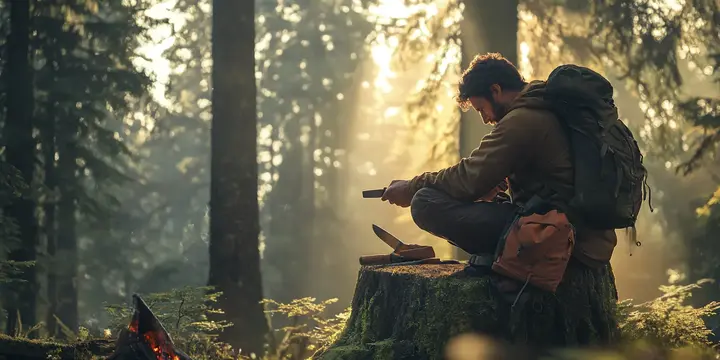
Maintaining your hunting knife is essential for optimal performance and longevity. Regular upkeep ensures safety and efficiency during your outdoor adventures. Here’s a comprehensive guide to proper knife maintenance:
Sharpening
A sharp blade is crucial for effective cutting and reduces the risk of accidents. Regular sharpening maintains the knife’s edge and ensures consistent performance. For precise sharpening, consider using a guided-angle sharpening system, which is user-friendly and delivers consistent results.
Cleaning
Thorough cleaning after each use prevents rust and maintains hygiene. Utilizing a multi-purpose cleaner that cleans, lubricates, and protects your blade in one step can be highly effective.
Storage
Proper storage significantly impacts the lifespan of your knife. Always store your knife in a dry place to prevent moisture-induced corrosion. Using a durable sheath provides an added layer of protection against physical damage and moisture.
Recommended Knife Maintenance Kits
Investing in a comprehensive knife maintenance kit simplifies the upkeep process. Here are some recommended kits:
- Iron Will Outfitters Complete Blade Care Kit: This kit includes a mineral oil dispensing pen, a 1200-grit diemaker polishing stone, a double-sided polishing cloth, a microfiber cleaning cloth, a Torx T6 L-Key, and a carry pouch. It’s designed to keep your blades in top shape, addressing natural surface tarnishing and preparing them for ongoing corrosion resistance.
- Knafs Loaded Tool Burrito – 13-in-1 Knife Maintenance Tool Kit: This all-in-one kit is perfect for both beginners and experts. It includes various tools for sharpening, cleaning, polishing, and protecting your knife collection. The heavy-duty waxed canvas construction helps resist moisture, and integrated magnets keep small knife parts secure during maintenance.
- Knife Pivot Lube Maintenance Kit: This kit offers premium knife lubricant, a microfiber cleaning cloth, VibraTite medium/removable threadlocker, ultra-fine microfiber detailing swabs, and a die-cut sticker. It’s designed to lubricate, maintain, clean, and detail your pocketknife effectively.
By dedicating time to proper maintenance, your hunting knife will serve you reliably, enhancing your outdoor experiences and ensuring safety during use.
Final Thoughts
Hunting with a knife is more than a sport; it’s a deeply personal and exhilarating experience. It’s a chance to hone your skills, connect with nature, and embrace the traditions of our ancestors.
Are you ready to take on the challenge of knife hunting? Share your experiences or questions in the comments below, and let’s continue the conversation about this thrilling and rewarding pursuit.
FAQ For Hunting With Knives
Is it legal to hunt with a knife?

The legality of hunting with a knife varies by state and country. Some areas allow knife hunting for certain game, such as wild boar, while others prohibit it altogether. Always check your local wildlife regulations before attempting to hunt with a knife.
What is the best type of knife for hunting?
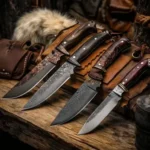
A good hunting knife should have a strong, sharp blade designed for skinning, gutting, and processing game. Drop point and clip point blades are popular choices due to their versatility. Fixed-blade knives are preferred for durability, while folding knives offer convenience.
Can you hunt boar with a knife?
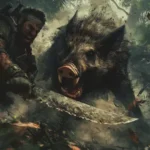
Yes, boar hunting with a knife is possible and is practiced in some areas, often with the assistance of hunting dogs to hold the animal. This method requires experience, a strong, durable knife (such as a spear-point or Bowie knife), and proper safety precautions.
How big of a knife do you need to field dress a deer?

A blade between 3.5 and 5 inches is ideal for field dressing a deer. A knife this size provides enough control for precise cuts without being too cumbersome. Larger knives can make delicate tasks more difficult.
What makes a knife a hunting knife?
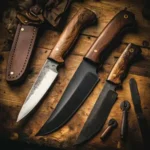
A hunting knife is specifically designed for processing game, featuring a sharp, durable blade with a shape suited for skinning and gutting. The handle should provide a secure grip, even in wet conditions, and the knife should be easy to clean and maintain.
How sharp should a hunting knife be?
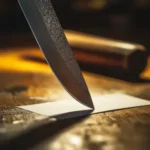
A hunting knife should be razor-sharp to ensure clean, efficient cuts. It should be sharp enough to slice through hide and muscle with minimal effort but not so thin that it loses edge retention quickly. Regular honing and sharpening are essential for maintaining performance.

